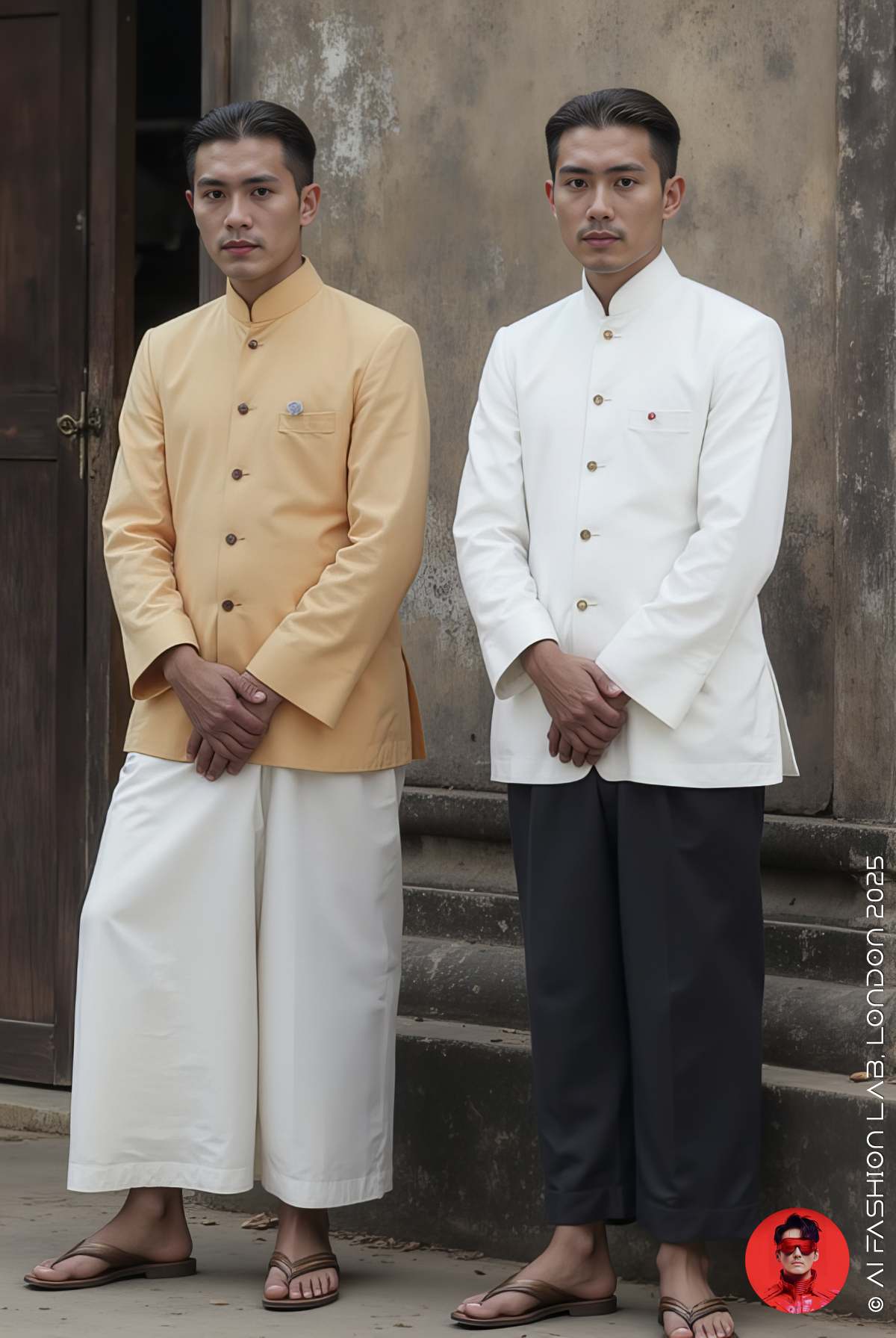การแต่งกายป้อจายเจียงใหม่ สมัยรัชกาลที่ 8 (ทศวรรษ 2470–2480)
การแต่งกายป้อจายเจียงใหม่ สมัยรัชกาลที่ 8 (ทศวรรษ 2470–2480)
คอลเลกชันที่สร้างขึ้นด้วย AI นี้ได้รับแรงบันดาลใจจากภาพถ่ายประวัติศาสตร์ที่แชร์โดยเพจเฟซบุ๊ก เชียงใหม่ที่คุณไม่เคยเห็น และ พิพัฒน์ วิพฑฺฒโน โดยภาพถ่ายต้นฉบับบันทึกเหตุการณ์ที่กลุ่มชาวบ้านร่วมงาน ปอยหลวงฉลองโรงเรียนปริยัติธรรม ณ วัดพระนอนหนองผึ้ง อำเภอสารภี จังหวัดเชียงใหม่
ภาพถ่ายนี้น่าจะถูกบันทึกไว้ในช่วงระหว่างปี พ.ศ. 2478–2482 ซึ่งเป็นช่วงต้นรัชสมัยของ พระบาทสมเด็จพระปรเมนทรมหาอานันทมหิดล (รัชกาลที่ 8) โดยสามารถสังเกตได้จากพระบรมฉายาลักษณ์ที่แขวนอยู่บนฝาผนังชั้นบนของเรือนไม้ ซึ่งช่วยยืนยันช่วงเวลาของภาพได้อย่างชัดเจน
สิ่งที่สะดุดตามากที่สุดในภาพนี้ คือ การแต่งกายของชายชาวเชียงใหม่ หลายคนสวม เสื้อราชประแตน คู่กับ กางเกงสะดอหรือกางเกงพื้นเมืองแบบทางเหนืออย่างเรียบร้อย ซึ่งใช้เป็นชุดพิธีการสำหรับงานบุญสำคัญทางพระพุทธศาสนา ซึ่งแตกต่างจากรูปแบบทางการของภาคกลางที่นิยมสวมเสื้อราชประแตนคู่กับ โจงกระเบน โดยเฉพาะในกรุงเทพฯ และพื้นที่โดยรอบ
ภาพนี้จึงนับเป็นหลักฐานสำคัญที่ให้เห็นถึง มุมมองด้านพิธีการของชายชาวล้านนา ผ่านเลนส์ของอัตลักษณ์ท้องถิ่นในช่วงเวลาที่ประเทศไทยกำลังเปลี่ยนผ่านสู่ยุคของการรวมศูนย์ทางวัฒนธรรม ซึีงสะท้อนให้เห็นถึงความภาคภูมิใจในรากเหง้าของผู้คนในภาคเหนือที่ยังคงแข็งแรง แม้สังคมไทยกำลังมุ่งสู่ความเป็นสมัยใหม่ในแบบรัฐชาติ
ที่สำคัญ ภาพถ่ายนี้เกิดขึ้นก่อนที่รัฐบาลจะประกาศใช้นโยบาย รัฐนิยม ในปี พ.ศ. 2484 ภายใต้การนำของ จอมพล ป. พิบูลสงคราม ซึ่งมุ่งส่งเสริมให้ประชาชนหันมาแต่งกายแบบตะวันตก และลดการแต่งกายแบบไทยดั้งเดิม โดยเฉพาะในผู้ชาย เช่นในนโยบาย “มาลานำไทย” ที่รณรงค์ให้ชายไทยสวมหมวกและแต่งตัวให้ดูทันสมัยแบบตะวันตก
ดังนั้น ภาพถ่ายนี้จึงเป็นเสมือน หน้าต่างแห่งกาลเวลา ที่บันทึกอัตลักษณ์ของล้านนาไว้ ก่อนจะเกิดการเปลี่ยนแปลงทางวัฒนธรรมครั้งใหญ่ในช่วงสงครามโลกครั้งที่ 2 และยุคแห่งความเป็นสมัยใหม่ที่ตามมา
เพื่อเป็นการให้เกียรติแก่ช่วงเวลาแห่งประวัติศาสตร์นี้ และอนุรักษ์ภาพลักษณ์ทางวัฒนธรรมที่ทรงคุณค่า ผมจึงได้สร้างผลงาน แฟชั่นป้อจายเจียงใหม่ด้วย AI โดยจินตนาการว่า ชายชาวเชียงใหม่ในช่วงปลายทศวรรษ 2470 สวมใส่ เสื้อราชประแตนสีขาว คู่กับ กางเกงสะดอ สะท้อนทั้งความเป็นทางการและความเป็นล้านนาในคราวเดียวกัน
ภาพเหล่านี้เป็น ภาพที่สร้างขึ้นด้วย AI ซึ่งเป็นการรังสรรค์เชิงดิจิทัลที่ตั้งใจจะเฉลิมฉลองและตีความถึงอัตลักษณ์ของป้อจายล้านนา และรูปแบบการแต่งกายของชายภาคเหนือในห้วงเวลาสำคัญของประวัติศาสตร์ไทย
Chiang Mai Men’s Fashion during the Reign of King Rama VIII (1930s–1940s)
This AI-enhanced collection is inspired by a historical photo shared by the Facebook pages เชียงใหม่ที่คุณไม่เคยเห็น and พิพัฒน์ วิพฑฺฒโน. The original photo captures a group of people attending the ปอยหลวงฉลองโรงเรียนปริยัติธรรม (Poi Luang celebration for the Pariyattidhamma school) at Wat Phra Non Nong Phueng in Saraphi District, Chiang Mai.
The photograph was most likely taken between 1935 and 1939, during the early reign of King Ananda Mahidol (Rama VIII). A framed royal portrait of the King is clearly visible on the wall of the upper floor of the wooden building, which helps to date the image.
What struck me most about this particular photograph was the fashion worn by Chiang Mai's local men. Many are dressed in เสื้อราชประแตน (Raj-pattern jackets) paired with กางเกงสะดอ – traditional northern-style wrap trousers – as formal attire for this important Buddhist celebration. This contrasts with the central Thai formal dress of เสื้อราชประแตน with โจงกระเบน (chong kraben), which was typical in Bangkok and other regions.
This image provides a rare glimpse into how Lanna men expressed formality through a regional lens during a period of intense national transformation. It reflects the strong sense of northern identity that persisted, even as the country approached centralised cultural reforms.
Importantly, the photograph predates the state-led cultural mandates known as รัฐนิยม (Ratthaniyom) introduced in 1941by Field Marshal Plaek Phibunsongkhram, which promoted Western-style clothing and discouraged traditional Thai attire. Campaigns such as “มาลานำไทย” further encouraged modernised appearance, especially among men. This makes the photograph a precious snapshot of northern heritage just before the sweeping changes of World War II and the nationalist modernisation policies that followed.
To honour this historical moment and preserve its visual legacy, I have created a fashion photography series using AI to reimagine how men in Chiang Mai during the late 1930s might have dressed for such ceremonial occasions. The models wear เสื้อราชประแตน (Raj-pattern jackets) with กางเกงสะดอ, echoing the formal yet regionally grounded attire seen in the original photo.
These AI-generated portraits are not real photographs but digital recreations meant to celebrate and visualise Lanna identity and northern men's fashion during a pivotal moment in Thai history.
#aifashionlab #AI #aiartist #aiart #aifashion #aifashiondesign #aifashionstyling #aifashiondesigner #fashion #fashionhistory #historyoffashion #fashionstyling #fashionphotography #digitalfashion #digitalfashiondesign #digitalcostumedesign #digitaldesign #digitalaiart #ThaiFashionHistory #ThaiFashionAI #flux #fluxlora




























































